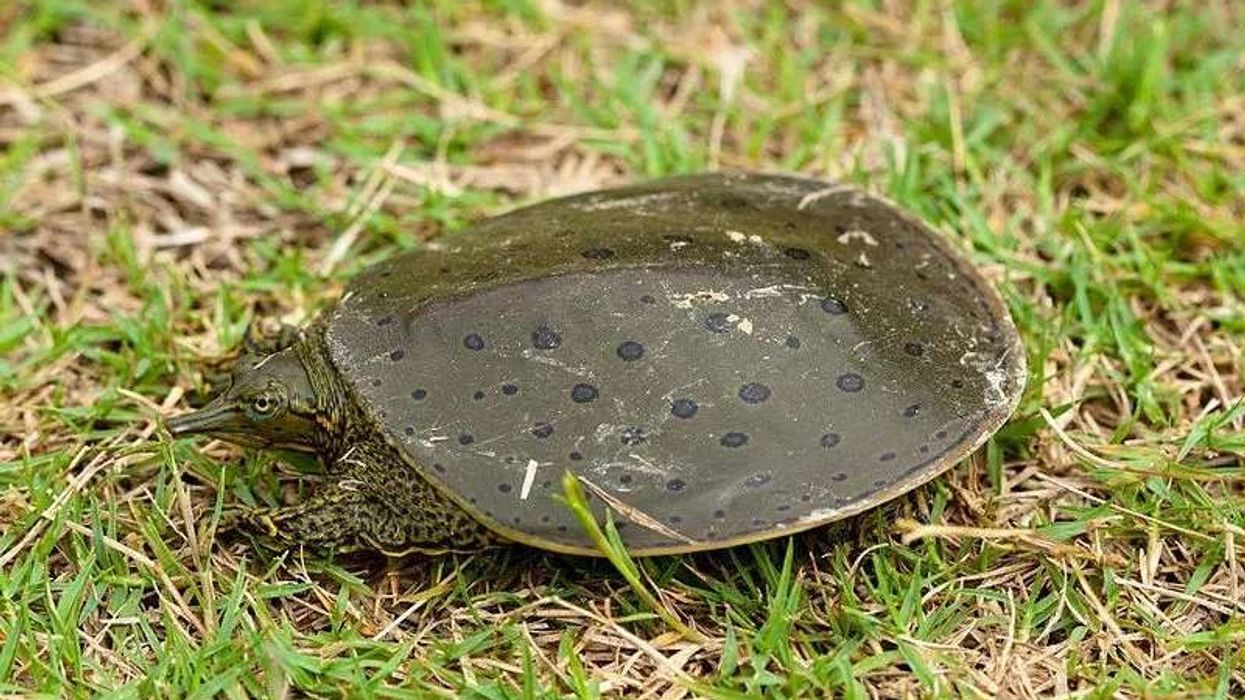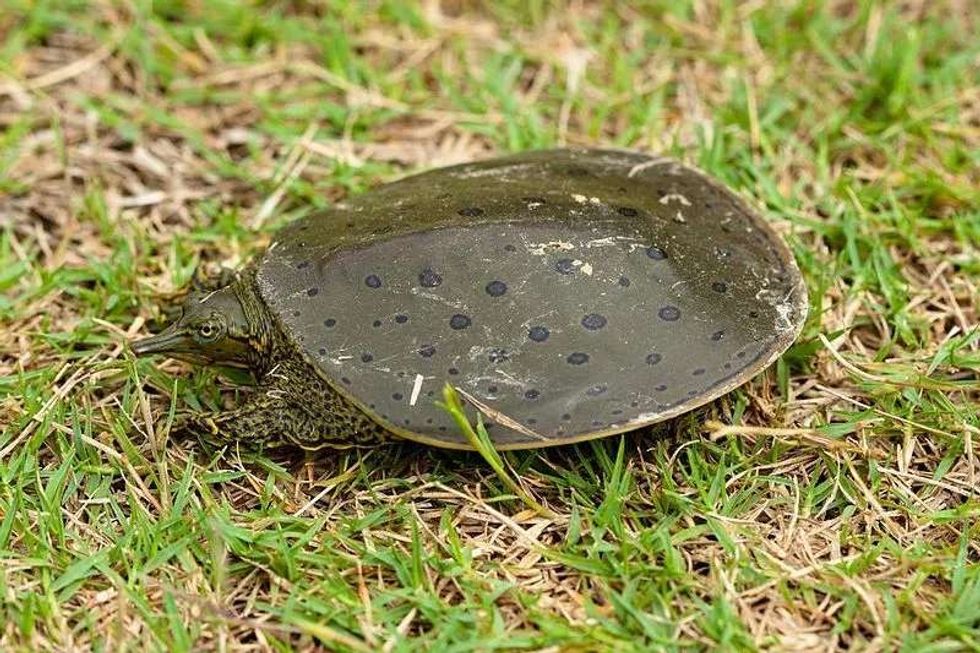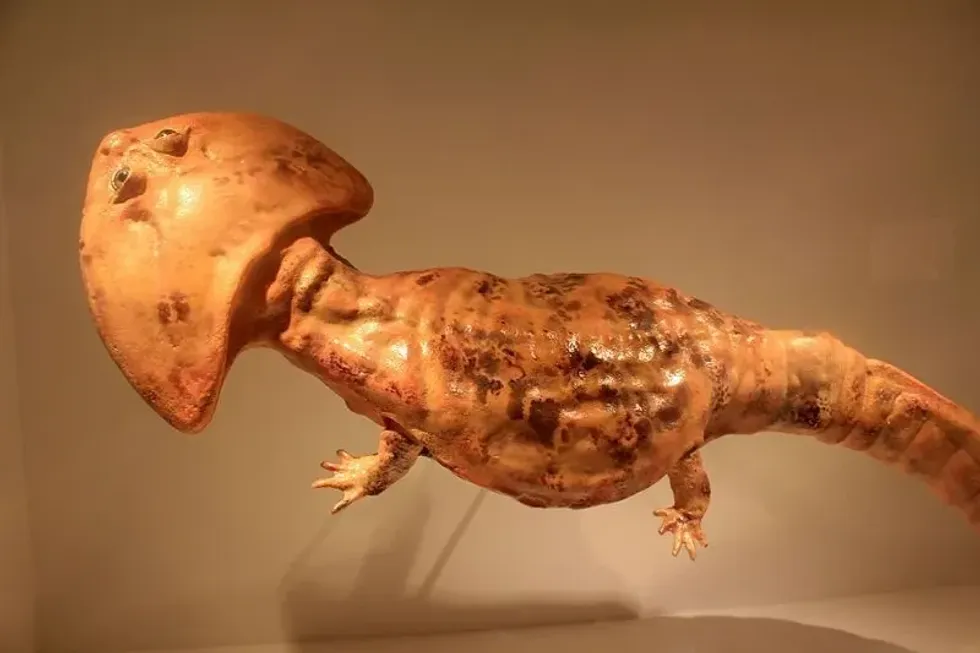Spiny Softshell turtles or Apalone spinifera as it is scientifically known belong to the Trionychidae family. The spiny softshell turtles belong to the class of reptiles.
These game fish populations have a promiscuous mating system. The mating process happens or takes place around mid-late spring in deep water.
This spiny softshell turtle nests more than once in a single breeding season. Around 9-38 round, calcareous eggs are laid around July and September, and these eggs hatch around spring.
These softshells can be found in farm ponds, lakes, river banks and rivers, tributaries, and streams and edges These spiny softshells are mostly found in shallow waters less than 1 m deep and sometimes, can also be seen in water as far as 10 m deep.
These spiny softshells have a leathery, moderately flexible carapace or shell and webbed feet with three claws each.
These claws are not very sharp. This reptile has an elongated nose. The lifespan status of these reptiles is 50 years or more.
The carapace or the upper part of the shell is brown or yellow-brown to olive in color and the plastron or the lower part is lighter in color and is usually white or yellow. The coloration pattern also includes pale lines running from face to neck.
The shell length of a female is greater than that of a male. Adult males look similar throughout their lifetime while a female of this species may have dark spots as it ages.
The food habits include preying or hunting the target by swimming. Subspecies include the Gulf coast, Pallid, Guadalupe, and eastern spiny softshell.
It is quite interesting to know about these Spiny softshell turtles so read on, and if you're interested, read about the Florida Softshell turtle and Hawksbill sea turtle too.
Spiny Softshell Turtle Interesting Facts
What type of animal is a Spiny Softshell Turtle?
Spiny Softshell turtles are softshell turtles.
What class of animal does a Spiny Softshell Turtle belong to?
It belongs to the class of Reptilia or reptiles.
How many Spiny Softshell Turtles are there in the world?
There has been no specific number of these Spiny Softshell turtles recorded in the world.
Where does a Spiny Softshell Turtle live?
Most of the Spiny Softshell turtle range includes the United States as well as the provinces of Ontario and Quebec in Canada and then south into some Mexican states.
What is a Spiny Softshell Turtle's habitat?
The Spiny Softshell turtle habitat includes freshwater bodies like streams, ponds, rivers, tributaries, and lakes. These are mostly found in shallow waters with a depth of less than 1 m but sometimes, can also be seen in waters as much as 10 m deep.
These turtles can be found in habitats where the levels of vegetation vary and can be seen in both slow-moving and fast-moving waters too.
These turtles prefer the waters they inhabit to have sand at the bottom and clean sandy banks which are important in terms of nesting sites. These turtles are known to migrate between the warm and cold seasons.
Who do Spiny Softshell Turtles live with?
They are mostly seen basking alone or in small groups.
How long does a Spiny Softshell Turtle live?
These turtles can live up to 50 years.
How do they reproduce?
Reproduction of these turtles is promiscuous and it takes place around mid to late spring in the deep waters. The males poke the heads of the females when swimming and if the female is receptive or wants to mate, the males tend to swim above the female without grasping or gripping her claws.
The eggs are laid in a sandbar or a gravel abundant cavity that is dug near the water.
The nesting happens more than once in a breeding or mating season.
Between 9-38 round, chalky eggs are laid around July and September, and the eggs hatch in spring. The young ones are not taken care of by the parents and only pre fertilization provisioning happens and these turtles mature when they are around 8-10 years old.
What is their conservation status?
The status of this species is the Least Concern category.
Spiny Softshell Turtle Fun Facts
What do Spiny Softshell Turtles look like?
These turtles have leathery carapaces that are fairly flexible. This is because of keratinized scutes and bony tissue loss. These turtles have webbed feet, with three claws.
These turtles also have a fleshy, elongated nose. The carapace or the upper part of the shell is brown or yellow-brown to olive in color and the plastron or the lower part is lighter in color and is usually white or yellow.
Hatchlings have dark spots on the upper part. As the females age, they tend to become darker, or sometimes they get splotched. Males look similar since birth.
These turtles are cryptically colored that helps them blend in with their surroundings. These turtles also have pale lines bordered with black lines running from their neck to head.
Females tend to grow larger than males. There may be certain differences among females and males of the species. There may be certain differences in appearance among subspecies based on the differences in environment.

How cute are they?
Some people consider these turtles cute because of the way they move.
How do they communicate?
These softshells are known to use their sense of vision and touch to perceive their environment and communicate and also are known to respond to tactile stimulation during mating or breeding.
How big is a Spiny Softshell Turtle?
The Spiny softshell turtle size is considered to be medium. These softshells can weigh up to 26 lb (12 kg) and their length ranges from 5-19 in (127-483 mm).
How fast can a Spiny Softshell Turtle move?
These turtles are known to move fast both on land and water, especially when agitated. These turtles can reach a speed of 15 mph (24 kph) on land.
How much does a Spiny Softshell Turtle weigh?
These softshells can weigh up to up to 26 lb (12 kg).
What are their male and female names of the species?
There are no specific names for males and females of the species.
What would you call a baby Spiny Softshell Turtle?
Baby spiny softshell turtles are called hatchlings.
What do they eat?
The Spiny softshell turtle diet or Apalone spinifera primarily preys on macroinvertebrates such as aquatic insects, crayfish, and occasionally a fish. These foods are found under the objects or in vegetation or along the floor of the lake. They also hide in floor substrate and grab prey or their food as they swim by.
Are they dangerous?
These turtles are vulnerable to predators and can be aggressive and tend to bite. A spiny softshell turtle bite can be painful.
Would they make a good pet?
These softshells are quite manageable as pets and thus, make good pets as compared to other large-sized turtles. Spiny softshell turtle care is not very difficult.
The spiny softshell turtle pet can be kept in large aquariums, which are at least 75-100 gallons large. It should be ensured that the water is kept clean and there is nothing sharp or rough that could hurt this turtle.
Did you know...
The scientific or the binomial name of this species, Apalone spinifera explains the appearance of this turtle. Apalone has its roots in the Greek word Apalos, which means soft and tender and spinifera is derived from the Latin word spina, which means thorn or spine, and ifer meaning bearing.
These Spiny softshells or the Apalone spinifera can perform oxygen and carbon dioxide exchange by breathing air or while breathing underwater. This means that this turtle species can live underwater for up to seven months.
This species has a low tolerance to hypoxic waters.
The carapace length of this freshwater turtle species ranges from 18-54 cm, with females growing larger than males.
These spiny softshell turtles are diurnal and spend most of the day basking and foraging for food.
The nests of this species are often destroyed by raccoons, skunks, and foxes. Adults are killed by humans and they have very few natural predators.
These turtle populations are sometimes marketed for human consumption and some places have made laws pertaining to catch limits, catch seasons as well as size limitations.
These turtles were previously known as Trionyx spiniferus and there are several subspecies including an Eastern spiny softshell turtle, western spiny softshell turtle, Gulf Coast spiny softshell turtle, pallid spiny softshell turtle, Guadalupe spiny softshell turtle, and Texas spiny softshell turtle.
The eastern softshells are found in good numbers in the Missouri River.
Unlike other turtles, the sex of these turtles is not determined by the environment and temperature variations but is determined genetically.
Do Spiny Softshell Turtles bite?
As these turtles are prone to predators, they can be aggressive and bite to defend themselves.
How does a Spiny Softshell Turtle protect itself?
Most turtles have a rigid shell that protects them from predators and this is a very important survival strategy but these softshell turtles have abandoned these hard shells and evolved a lifestyle that compensates for this lack of hard shells.
These turtles spend most of their time in the water around sandy bottoms and their body is camouflaged well to their surroundings and environments which sometimes make it difficult for the predators to find them.
Here at Kidadl, we have carefully created lots of interesting family-friendly animal facts for everyone to discover! Learn more about some other reptiles including the snapping turtle, or Olive Ridley sea turtle.
You can even occupy yourself at home by drawing one on our softshell turtle coloring pages.









